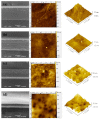Characterization of Hydrophilic Polymers as a Syringe Extrusion 3D Printing Material for Orodispersible Film
- PMID: 34685213
- PMCID: PMC8540066
- DOI: 10.3390/polym13203454
Characterization of Hydrophilic Polymers as a Syringe Extrusion 3D Printing Material for Orodispersible Film
Abstract
The application of hydrophilic polymers in designing and three-dimensional (3D) printing of pharmaceutical products in various dosage forms has recently been paid much attention. Use of hydrophilic polymers and syringe extrusion 3D printing technology in the fabrication of orodispersible films (ODFs) might hold great potential in rapid drug delivery, personalized medicine, and manufacturing time savings. In this study, the feasibility of 3D-printed ODFs fabrication through a syringe extrusion 3D printing technique and using five different hydrophilic polymers (e.g., hydroxypropyl methylcellulose E15, hydroxypropyl methylcellulose E50, high methoxyl pectin, sodium carboxymethylcellulose, and hydroxyethylcellulose) as film-forming polymers and printing materials has been investigated. Rheology properties and printability of printing gels and physicochemical and mechanical properties of 3D-printed ODFs were evaluated. Amongst the investigated hydrophilic polymers, sodium carboxymethylcellulose at a concentration of 5% w/v (SCMC-5) showed promising results with a good printing resolution and accurate dimensions of the 3D-printed ODFs. In addition, SCMC-5 3D-printed ODFs exhibited the fastest disintegration time within 3 s due to high wettability, roughness and porosity on the surface. However, the results of the mechanical properties study showed that SCMC-5 3D printed ODFs were rigid and brittle, thus requiring special packaging to prevent them from any damage before practical use.
Keywords: disintegration; hydrophilic polymer; orodispersible film; syringe extrusion 3D printing.
Conflict of interest statement
The authors declare no conflict of interest.
Figures



References
-
- Mohamed E.M., Ali S.F.B., Rahman Z., Dharani S., Ozkan T., Kuttolamadom M.A., Khan M.A. Formulation optimization of selective laser sintering 3D-printed tablets of clindamycin palmitate hydrochloride by response surface methodology. AAPS PharmSciTech. 2020;21:1–15. doi: 10.1208/s12249-020-01775-0. - DOI - PubMed
Grants and funding
LinkOut - more resources
Full Text Sources

